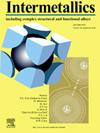The effect of microstructure evolution on the high-temperature mechanical properties and creep behavior of Y2O3-bearing alloy
IF 4.3
2区 材料科学
Q2 CHEMISTRY, PHYSICAL
引用次数: 0
Abstract
In this study, various heat treatment processes were employed to adjust the ratio of blocky γ phase to α2/γ lamellae and to create conditions conducive to the precipitation of Y2O3 nanoparticles. The aim was to investigate the influence of microstructure evolution on the high-temperature mechanical properties and creep behavior of the Ti-48Al-2Cr-2Nb-0.05Y2O3 alloy. As the holding temperature increases from 1200 °C to 1350 °C, the content of the blocky γ phase decreases from 61.49 % to 1.12 %, resulting in the formation of nearly duplex (NDP) microstructure, duplex (DP) microstructure, nearly lamellar (NL) microstructure, and fully lamellar (FL) microstructure. The combination of elevated temperature conditions and increased crystal defects promotes the precipitation of Y2O3 nanoparticles, leading to the highest number of nanoscale reinforcements within the FL microstructure. As the heat-treated sample transitions from the NDP to FL microstructure, the ultimate tensile strength tested at 800 °C increases from 384 MPa to 668 MPa, while the creep life tested at 800 °C under 325 MPa improves from 10.8 h to 138.2 h. The elongation and creep strain initially increase and then decrease, with the heat-treated sample exhibiting an NL microstructure demonstrating the best high-temperature elongation of 21.48 % and the highest creep strain of 19.55 %. The favorable ductility and deformation capacity observed in the NL microstructure can be attributed to the cooperative deformation of the lamellar structure and its surrounding blocky γ phase. The excellent high-temperature strength and creep resistance of the FL microstructure result from the synergistic strengthening effect arising from a greater number of nanoscale Y2O3 precipitates and the highest content of lamellar colonies, which provide an effective pinning effect on dislocation movement. In comparison to commonly used reinforcements, the heat-treated TiAl alloys reinforced with dual-scale Y2O3 particles exhibit remarkable high-temperature properties, which are anticipated to further enhance the service temperature of TiAl alloys and expand their application at elevated temperatures.
求助全文
约1分钟内获得全文
求助全文
来源期刊

Intermetallics
工程技术-材料科学:综合
CiteScore
7.80
自引率
9.10%
发文量
291
审稿时长
37 days
期刊介绍:
This journal is a platform for publishing innovative research and overviews for advancing our understanding of the structure, property, and functionality of complex metallic alloys, including intermetallics, metallic glasses, and high entropy alloys.
The journal reports the science and engineering of metallic materials in the following aspects:
Theories and experiments which address the relationship between property and structure in all length scales.
Physical modeling and numerical simulations which provide a comprehensive understanding of experimental observations.
Stimulated methodologies to characterize the structure and chemistry of materials that correlate the properties.
Technological applications resulting from the understanding of property-structure relationship in materials.
Novel and cutting-edge results warranting rapid communication.
The journal also publishes special issues on selected topics and overviews by invitation only.
 求助内容:
求助内容: 应助结果提醒方式:
应助结果提醒方式:


